
Cover image created using photo by Braedon McLeod on Unsplash
Nana: Ugh! What are you doing? Shoo, shoo!
Nina: But Nana, everyone likes soap bubbles. Even a grouch like you can’t dislike them.
Nana: Of course I do, when you send them swarming around my head like mosquitoes.
Nina: Nana, stop bursting them. They’re so pretty. Can’t you see how the different colors wiggle and shimmer on their surface. It’s because the waves of different frequencies interfere in different ways. The visibility of the colors that interfere constructively is enhanced, while the colors that interfere destructively are suppressed making the bubble colorful even when it is exposed only to white light.
Nana: Are you a poet or a scientist now?
Nina: Who says I can’t be both?
Nana: Who says you can be either? Ouch, that one burst in my eye. Ouch, ouch, my eye is burning.
Nina: Don’t be such a baby, Nana. Perhaps, you would prefer the everlasting bubbles? I was reading about them, and that’s what reminded me how much I like blowing bubbles.
Nana: Allow me to burst your bubble. Everlasting bubbles is an oxymoron. All you need to do to burst a bubble, is thwack it.
Nina: Actually Nana, you don’t even need to do that. Soap bubbles are ephemeral, even if we leave them alone. In a little while, most of the water content of the soap bubble goes to the bottom because of gravity, straining the thin film and causing the bubble to burst. Evaporation also weakens the bubble.
Nana: See, there’s no such thing as an everlasting bubble.
Nina: True. That was merely hyperbole. But scientists have designed a bubble, that if left alone, can last more than a year.
Nana: A year!! No way!!
Nina: Way! These bubbles were not made using soap water, but a mixture of microscopic plastic particles, water and glycerol. The glycerol absorbs water from the atmosphere and balances water loss due to evaporation.
Nana: But what about the water going to the bottom?
Nina: That’s where the plastic micro-particles come in. They cling to the water molecules maintaining an even thickness all over the bubble.
Nana: But what use is all this? It is too elaborate to make for kids to have fun with, which is probably the only use of soap bubbles. Seems like a pointless, complicated, overrated balloon. Are scientists wasting tax payer money for such silly projects? You seem to be contagious.
Nina: Nana, only you can be so grumpy about bubbles. Besides they do have potential use in medicine to improve aerosols and sprays by making them last longer. But what’s even more fascinating is they have created a pyramid shape with this liquid mixture by carefully lifting a metal frame out of this liquid so it had a thin film stretched between the edges. The pyramid has lasted for more than a year.
Nana: Still, doesn’t seem very useful.
Nina: But that’s how science works. Scientists follow their curiosity, and who knows where it can lead them. From penicillin to microwaves, so many life changing discoveries were just an outcome of scientists tinkering and playing around with new ideas and equipment. It’s mind blowing if you know what I mean. <Nina winks and blows a host of bubbles towards Nana.>
Nana: Ouch. That’s another one in my eye. Get away from here before I bubble wrap you, and ship you off to Timbuktu.
This post is a part of the #NinaAndNana series I co-host with Lavanya Srinivasan. Her posts can be found here.